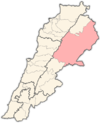Labweh
اللبوة | |
Byzantine | |
| Site notes | |
|---|---|
| Excavation dates | 1966, 1969 |
| Archaeologists | Diana Kirkbride, Lorraine Copeland, Peter Wescombe |
| Condition | Ruins |
| Public access | Yes |
Labweh (
History
The
Labweh in the original
In 1834,
Labweh Springs and Labweh River
The village is located on a hill 26 kilometres (16 mi) northeast of
Archaeological sites
Soundings and analysis of archaeological sites in Labweh were made by Lorraine Copeland and Peter Wescombe in 1966 with later excavations by Diana Kirkbride in 1969.[11] Tell Labweh, Tell Labweh South or Labweh I sits to the south of the village with another site to the north. The surface of Tell Labweh had been damaged by modern agriculture and it had been cut in half by road construction. Several burials were discovered inside the remains of rectangular buildings with white and red plaster floors. The remains of stone walls were found at lower levels and it is thought that the buildings may have used mud bricks at higher levels.[12]
Early
Tell Labweh North is another large archaeological site, a few hundred meters north on the other side of the village and springs. Finely denticulated sickle blades,
Roman temple
There are the ruins of a Roman temple in the village that are included in a group of Temples of the Beqaa Valley.[15] It was a prostyle type but only one block of the western wall remained visible. Modern construction built a house inside the temple.[16] There are around twenty temples located between Labweh and Ain el-Baid.[17]
References
- ^ a b Ba'albeck - Al-Hermal, Bekaa - Tourist Brochure
- ^ a b Royal Geographical Society (Great Britain) (1837). The journal of the Royal Geographic Society of London. J. Murray. pp. 99–. Retrieved 16 March 2011.
- ^ Mazar (Maisler), B. (1946). "Topographical Studies V: Lebo-Hamath and the Northern Boundary of Canaan". Bulletin of the Israel Exploration Society. 12: 91–102.
- ^ 1 Kings 8:65
- ISBN 978-0-8028-2536-0. Retrieved 16 March 2011.
- NIVtranslation, which refers to the Dead Sea
- ^ Burckhardt Barker, 1837, p. 99
- ^ Robinson and Smith, 1841, vol 3, 2nd appendix, p. 145
- ^ Sir. William Smith, LLD, Ed. Dictionary of Greek and Roman Geography (1854)
- ^ Society for the Diffusion of Useful Knowledge (Great Britain) (1842). Penny cyclopaedia of the Society for the Diffusion of Useful Knowledge. C. Knight. pp. 469–. Retrieved 17 March 2011.
- ^ Zeidan Abdel-Kafi Kafafi (1982). The Neolithic of Jordan (East Bank). Papyrus Druck. Retrieved 16 March 2011.
- ^ a b c d Moore, A.M.T. (1978). The Neolithic of the Levant. Oxford University, Unpublished PhD Thesis. pp. 192–198.
- ^ University of Cologne - Radiocarbon Context Database
- ISBN 978-0-87365-951-2. Retrieved 16 March 2011.
- ^ George Taylor (1967). The Roman temples of Lebanon: a pictorial guide. Dar el-Machreq Publishers. Retrieved 28 October 2012.
- ISBN 978-1-57506-014-9. Retrieved 28 October 2012.
- ^ Baal: Bulletin d'archéologie et d'architecture libanaises. Direction Générale des Antiquités. 2001. Retrieved 28 October 2012.
Literature
- Burckhardt Barker, W. (1837). "Notes Made on a Journey to the Source of the River Orontes in Syria, in September, 1834". Journal of the Royal Geographical Society of London. 7: 95–102.
- Copeland, Lorraine and Westcombe, Peter, Inventory of Stone Age Sites in Lebanon Part 2: North - South - East Central Lebanon Volume 42 (Pages 1–174) Mélanges de l'Université Saint-Joseph (Beirut Lebanon), 1966.
- Kirkbride, Diana, Early Byblos and the Bakaa, Volume 45 (Pages 43–60), Mélanges de l'Université Saint-Joseph (Beirut Lebanon), 1969.
- Robinson, E.; Smith, E. (1841). Biblical Researches in Palestine, Mount Sinai and Arabia Petraea: A Journal of Travels in the year 1838. Vol. 3. Boston: Crocker & Brewster.
External links
- Lebwe temple on www.lebanon.com
- Laboueh, Localiban


